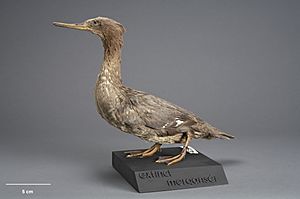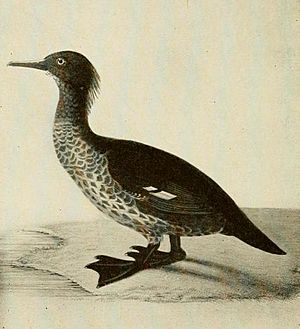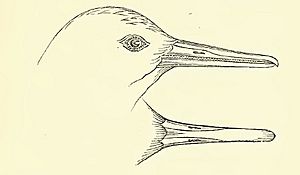New Zealand merganser facts for kids
Quick facts for kids New Zealand merganserTemporal range: Late Holocene
|
|
|---|---|
 |
|
| Stuffed specimen from 1902 | |
| Conservation status | |
| Scientific classification | |
| Genus: |
Mergus
|
| Species: |
australis
|
The New Zealand merganser was a type of duck that used to live in New Zealand. It is also known as the Auckland merganser or Auckland Islands merganser. Sadly, this special duck is now extinct, meaning there are none left alive today.
Contents
What Did the New Zealand Merganser Look Like?
This duck was about the same size as a red-breasted merganser. The adult male merganser had a dark reddish-brown head. It also had a crest (a tuft of feathers) and neck of the same color. Its back and tail feathers were bluish-black. Its wings were a slate grey color. Female mergansers were a bit smaller than the males. They also had a shorter crest.
When Did We First Learn About This Duck?
Scientists first collected a New Zealand merganser in 1840. This happened during a French expedition, which is a journey for exploration. The expedition was led by Jules Dumont d'Urville. His ships, L'Astrolabe and La Zelee, visited the Auckland Islands.
Why Did the New Zealand Merganser Disappear?
The number of New Zealand mergansers started to go down. This was because people hunted them. Also, new animals like cats and rats were brought to the islands. These new animals hunted the ducks, which is called predation. The ducks were not able to fly away easily. They preferred to hide among rocks when they were chased.
The last time anyone saw a New Zealand merganser was on January 9, 1902. A pair of ducks was shot on that day. People searched for the bird in 1909, but they could not find any. Later, in 1972 and 1973, a careful search was done. Experts looked at all the places where the duck might have lived. They concluded that the New Zealand merganser had been extinct for a long time.
Where Else Did They Live?
Scientists have found old bones, called fossils, of this merganser. These fossils show that the duck used to live in the South Island of New Zealand. They also lived on Stewart Island/Rakiura. Fossils of a similar type of merganser have been found on the Chatham Islands. There is also a small note from 1842 that mentions a "merganser" on Campbell Island. However, this might have been a different bird, the Campbell teal.
See also
 In Spanish: Serreta de Auckland para niños
In Spanish: Serreta de Auckland para niños




